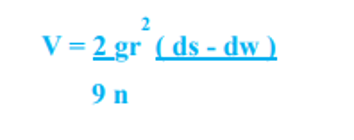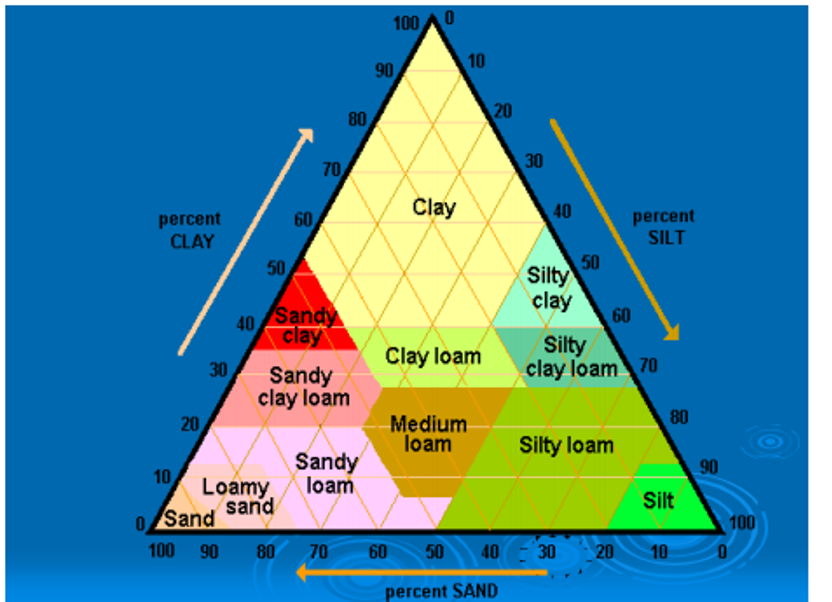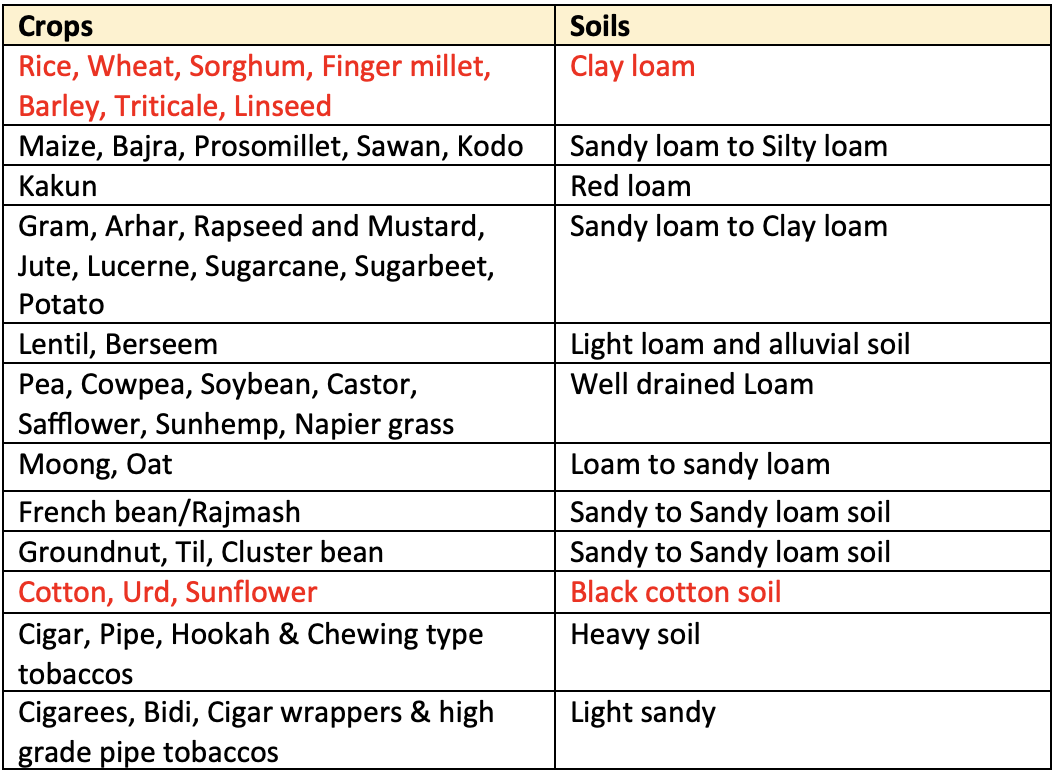🍪 Soil Texture
Textural classes, Stokes' Law, Importance
- Physical properties (mechanical behaviour) of a soil greatly influence its use and behaviour towards plant growth. The plant support, root penetration, drainage, aeration, retention of moisture, and plant nutrients are linked with the physical condition of the soil. Physical properties also influence the chemical and biological behaviour of soil. The physical properties of a soil depend on the amount, size, shape, arrangement and mineral composition of its particles. These properties also depend on organic matter content and pore spaces.
👉🏻 Important physical properties of soils
- Soil texture
- Soil structure
- Surface area
- Soil density
- Soil porosity
- Soil colour
- Soil consistence
Soil texture
- Soil texture refers to the
relative proportion of particlesor it is the relative percentage by weight of the three soil separates viz., sand, silt and clay or simply refers to the size of soil particles. - The proportion of each size group in a given soil (the texture) cannot be easily altered and it is considered as a
basic property of a soil. - The soil separates are defined in terms of diameter in millimeters of the particles. Soil particles more than 2 mm in diameter are excluded from soil textural determinations.
- Stones and gravels may influence the use and management of land because of tillage difficulties but these larger particles make little or no contribution to soil properties such as WHC and capacity to store plant nutrients and their supply.
- Knowledge on Texture is important. It is a guide to the value of the land. Land use capability and methods of soil management depends on Texture.

- Particles
less than 2 mmis called fine earth, normally considered in chemical and mechanical analysis. - The components of fine earth: Sand, Silt and Clay (Soil separates). The size limits of these fractions have been established by various organizations.
- There are a number of systems of naming soil separates
- The American system developed by USDA
- The English system or British system (BSI)
- European system
- 👉🏻 The International system (ISSS)

Sand
- Usually consists of quartz but may also contain fragments of feldspar, mica and occasionally heavy minerals viz., zircon, Tourmaline and hornblende.
- Has uniform dimensions
- Can be represented as spherical
- Not necessarily smooth and has jagged surface
Silt
- Particle size intermediate between sand and clay
- Since the size is smaller, the surface area is more
- Coated with clay
- Dominant minerals in silt are Quartz and Feldspar.
- Has the physico-chemical properties as that of clay to a limited extent
- Sand and Silt forms the SKELETON
Clay
- Particle size
less than 0.002 mm - Clay particles commonly are platy (needle like) in shape and highly plastic when moist.
- lt exhibits properties like flocculation, deflocculation and plasticity.
- They have highest surface area since surface area is inversely related to size.
- Clay behaves like a weak acid which is neutralized by bases thus serving as store house for several nutrients.
- These are secondary minerals derived from primary minerals in the rock
- Flesh of the soil
Marlingis the application of clay to sandy soils.
Particle size distribution/ determination
- The determination of relative distribution of the ultimate or individual soil particles below 2 mm diameter is called as
Particle size analysisorMechanical analysis. - Mechanical analysis of soil separates i.e. the percentage of sand, silt and clay is done by
Hydrometric method.

Two steps are involved
- Separation of all the particles from each other i.e. Complete dispersion into ultimate particles
- Measuring the amount of each group
Separation

- After removing the cementing agents, disperse by adding NaOH
Measurement
👉🏻 Once the soil particles are dispersed into ultimate particles, measurement can be done
- Coarser fractions – sieving – sieves used in the mechanical analysis corresponds to the desired particle size separation for 2 mm, 1 mm and 0.5 mm – sieves with circular holes. For smaller sizes, wire mesh screens are used (screening)
- Finer fractions – by settling in a medium.
- The settling or the velocity of the fall of particles is influenced by
- Viscosity of the medium
- Difference in density between the medium and falling particles
- Size and shape of object
Stokes’ Law
- Particle size analysis is based on a simple principle i.e. “when soil particles are suspended in water they tend to sink. Because there is little variation in the density of most soil particles, their velocity (V) of settling is proportional to the square of the radius ‘r’ of each particles. Thus,
V = kr2
- Where k is a constant.
- This equation is referred to as
Stokes' law. - Stokes (1851) was the first to suggest the relationship between the radius of the particles and its rate of fall in a liquid. He stated that “the velocity of a falling particle is proportional to the square of the radius and not to its surface. The relation between the diameter of a particle and its settling velocity is governed by Stokes’ Law:

- Where,
- V - velocity of settling particle (cm/sec)
- g - acceleration due to gravity cm/ sec2 (981)
- ds - density of soil particle (2.65)
- dw - density of water (1)
- n - coefficient of viscosity of water (0.0015 at 4°C)
- r - radius of spherical particles (cm)
Assumptions and Limitations of Stokes’ Law
- Particles are rigid and spherical / smooth. This requirement is very difficult to fulfill, because the particles are not completely smooth over the surface and spherical. It is established that the particles are not spherical and irregularly shaped such as plate and other shapes.
- The particles are large in comparison with the molecules of the liquid so that in comparison with the particle the medium can be considered as homogenous i.e. the particles must be big enough to avoid Brownian movement. The particles less than 0.0002 mm exhibit this movement so that the rate of falling is varied.
- The fall of the particles is not hindered or affected by the proximity (very near) of the wall of the vessel or of the adjacent particles. Many fast falling particles may drag finer particles down along with them.
- The density of the particles and water and as well as the viscosity of the medium remain constant. But this is usually not so because of their different chemical and mineralogical composition.
- The suspension must be still. Any movement in the suspension will alter the velocity of fall and such movement is brought by the sedimentation of larger particles (> 0.08 mm). They settle so fast and create turbulence in the medium.
- The temperature should be kept constant so that convection currents are not set up.
Methods of Textural determination
👉🏻 Numerous methods for lab and field use have been developed
- Elutriation method – Water & Air
- Pipette method
- Decantation/ beaker method
- Test tube shaking method
- Feel method – Applicable to the field – quick method – by feeling the soil between thumb and fingers
Feel Method
- Evaluated by attempting to squeeze the moistened soil into a thin ribbon as it is pressed with rolling motion between thumb and pre finger or alternately to roll the soil into a thin wire.
- Four aspects to be seen
- Feel by fingers
- Ball formation
- Stickiness
- Ribbon formation
Soil Textural Classes
Sands
- The sand group includes all soils which contains more than 85 % sand and the clay separate 15% or less of the material by weight.
- The properties of such soils are therefore characteristically those of sand in contrast to the stickier nature of clays.
- Two specific textural classes are recognized in this group sandy and loamy sand although in practice two subclasses are also used Loamy fine sand and loamy very fine sand.
Silt
- The silt group includes soils with at least 80% silt and 12% or less clay.
- Naturally the properties of this group are dominated by those of silt.
- Only one textural class - Silt is included in this group.
Clays
- To be designated a clay a soil must contain at least 35% of the clay separate and in most cases not less than 40%.
- In such soils the characteristics of the clay separates are distinctly dominant, and the class names are clay, sandy clay and silty clay.
- Sandy clays may contain more sand than clay.
- Likewise, the silt content of silty clays usually exceeds clay fraction.
Determination of Textural Class
- In the American system as developed by the United State Department of Agriculture
twelvetextural classes are proposed.
The textural triangle
- It is used to determine the soil textural name after the percentages of sand, silt, and clay are determined from a laboratory analysis. Since the soil’s textural classification includes only mineral particles and those of less than 2 mm diameter, the sand plus silt plus clay percentages equal 100 percent. (Note that organic matter is not included)

Textural classes of soils

Importance of Soil Texture
- Three broad and fundamental, groups of soil textural classes are sands, loams and clays. An ideal loam is defined as the mixture of sand, silt and clay particles, that exhibits light and heavy properties in about equal proportions. Roughly it is a half and half mixture on the basis of properties.
- Loamy soils are
best for agricultural productionbecause they retain more water and nutrients than sandy soils and have better drainage, aeration and tillage properties than clay soils. - Soil texture influences soils physical and chemical properties like water holding capacity, nutrient retention, nutrient fixation, nutrient availability, drainage, strength, compressibility and thermal regime.
- The clay imparts cohesion and sickness and fine texture to the soil and induces resistance to the passage of implements or in other words it makes the soil ‘heavy’.
- Comparatively sandy soils offer
little resistance to implementsand are called ‘light soil’. - The term heavy and light refer to the degree of resistance offered by soil to the passage of implements, but not to its weight in fact the heavy clay soil weigh less than an equal volume of the light sandy soil.
- Rice, Cotton, Sorghum, Coriander are grown on heavy textural soils which include clay loam, silty clay loam, silty clay and clay.
- Medium textured soils like loams, silt loams, silts and sandy loams are suitable for most of the crops.
- Sandy, loamy sand, sandy loam and sandy clay are light textured soils and these are suitable for groundnut, potato, tobacco, pearl millet and leguminous fodder crops.
- Generally, the best agriculture soils are those contain 10 – 20 per cent clay, 5 – 10 per cent organic matter and the rest equally shared by silt and sand and 30% silt - called as clay rather than clay loam.
Crops Soils

- Physical properties (mechanical behaviour) of a soil greatly influence its use and behaviour towards plant growth. The plant support, root penetration, drainage, aeration, retention of moisture, and plant nutrients are linked with the physical condition of the soil. Physical properties also influence the chemical and biological behaviour of soil. The physical properties of a soil depend on the amount, size, shape, arrangement and mineral composition of its particles. These properties also depend on organic matter content and pore spaces.
👉🏻 Important physical properties of soils
- Soil texture
- Soil structure
- Surface area
- Soil density
- Soil porosity
- Soil colour
- Soil consistence
Soil texture
- Soil texture refers to the
relative proportion of particlesor it is the relative percentage by …
Become Successful With AgriDots
Learn the essential skills for getting a seat in the Exam with
🦄 You are a pro member!
Only use this page if purchasing a gift or enterprise account
Plan
Rs
- Unlimited access to PRO courses
- Quizzes with hand-picked meme prizes
- Invite to private Discord chat
- Free Sticker emailed
Lifetime
Rs
1,499
once
- All PRO-tier benefits
- Single payment, lifetime access
- 4,200 bonus xp points
- Next Level
T-shirt shipped worldwide

Yo! You just found a 20% discount using 👉 EASTEREGG

High-quality fitted cotton shirt produced by Next Level Apparel